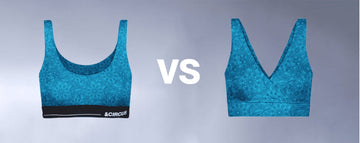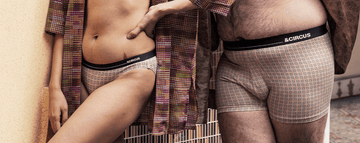A quiet revolution is unfolding in the most intimate corner of our wardrobes: underwear. Consumers are demanding more not just comfort, but fabrics that feel good on the skin and the conscience. This shift isn't happening in isolation. Behind the scenes, advisory boards and sustainability panels are steering brands toward organic materials, reshaping how innerwear is sourced and sold. These aren't just trendsetters; they're gatekeepers of a movement prioritizing transparency, eco-consciousness, and skin-friendly fabrics.
Uncomfortable underwear shouldn't steal your confidence. At Andcircus, we craft ultra-soft, sustainable Lenzing Modal Micro® innerwear for every body, XS to 5XL. From briefs to bras, our custom packs fit you perfectly. Shop risk-free with our 100% satisfaction guarantee and embrace comfort that includes everyone. #LoveEveryBody. Shop Now!
How Advisory Boards Are Shaping Organic Material Choices in Sustainable Innerwear
The fashion industry has long been a battleground for sustainability, but innerwear where fabric meets skin demands a special kind of scrutiny. Advisory boards, often composed of sustainability experts, dermatologists, and circularity consultants, are becoming pivotal in guiding brands toward organic materials like cotton, bamboo, and hemp. Their influence is evident in the growing popularity of certifications like OEKO-TEX and GOTS, which assure consumers that their underwear is free from harmful chemicals and produced ethically. According to a recent report, the global organic bedding market, which shares similar material priorities, reached $531.3 million in 2024 and is projected to hit $942 million by 2033, driven by rising awareness of organic product's benefits. This trend spills over into apparel, where innerwear brands are leaning into the same eco-friendly ethos.
Why does this matter? Innerwear isn't just clothing; it's personal. Fabrics like organic cotton or linen, grown without synthetic pesticides or GMOs, are less likely to irritate sensitive skin. For brands, the stakes are high: get the material wrong, and you risk alienating a customer base increasingly vocal about sustainability. Advisory boards bridge this gap, blending science, ethics, and market savvy to curate fabrics that feel luxurious yet responsible.
The Rise of Thoughtful Fabric Governance
The days of slapping “eco-friendly” on a label without scrutiny are fading. Today's brands are assembling cross-functional teams to oversee material choices. These boards aren't just checking boxes; they're diving into the nitty-gritty of supply chains, ensuring fabrics are traceable and certified. Take organic cotton: it's not enough to source it; brands must verify it meets standards like the Global Organic Textile Standard (GOTS). Bamboo and micromodal are also gaining traction, prized for their softness and sustainability. Meanwhile, hemp, once a niche player, is emerging as a low-water, high-durability option.
This shift isn't just about materials it's about accountability. Boards are pushing for transparency, demanding proof of ethical sourcing from farm to factory. The result? A new standard where certifications aren't just badges but promises kept. In North America, which holds the largest share of the organic bedding market, favorable government policies and rising consumer purchasing power are fueling this trend, with similar dynamics at play in apparel. It's a slow but steady pivot from synthetic blends to fabrics that breathe, biodegrade, and tell a story of care.
Brands Leading the Way
Some innerwear brands are already setting the pace. Take a sustainable lingerie company that, guided by its advisory panel, switched entirely to organic bamboo. The result? Silky, breathable garments that customers rave about for comfort and eco-credentials. Another brand, collaborating with textile innovation labs, has embraced regenerative cotton a fiber grown to restore soil health. These companies aren't just selling underwear; they're selling a vision of intimacy that's kind to both body and planet.
Consider the broader context: the organic insulation materials market, valued at $11,029.14 million in 2024, is expected to reach $21,074.79 million by 2033, with a growth rate of 7.46% annually, per industry insights from Global Growth Insights. While focused on construction, this market reflects a parallel demand for organic, energy-efficient solutions principles that translate to apparel. Innerwear brands tapping into this ethos are finding that curated materials resonate with eco-conscious consumers, particularly in North America, where the U.S. accounts for 30% of the organic insulation market share.
The Hurdles of Going Organic
Switching to organic isn't a simple flip of a switch. Organic materials often come with higher costs due to limited sourcing regions and rigorous certification processes. Scaling newer options like seaweed fiber or regenerative cotton can strain supply chains, especially when global demand outpaces production. Then there's the consumer education gap: not everyone understands why organic cotton feels different or why certifications matter. Brands must invest in storytelling on labels, websites, and social media to bridge this divide.
Yet, the challenges aren't insurmountable. Advisory boards are helping brands navigate these waters, balancing innovation with feasibility. By partnering with textile labs and sustainability experts, companies are finding ways to streamline sourcing without compromising quality. It's a delicate dance, but one that's paying off as consumers reward brands that prioritize transparency.
The Business Case for Curated Materials
Curating organic materials isn't just ethical it's smart business. Brands that weave sustainability into their story stand out in a crowded market. Transparent material choices, backed by certifications, build trust and reduce return rates, as customers appreciate fabrics that don't itch or irritate. Data backs this up: the demand for skin-friendly, eco-conscious innerwear is climbing, mirroring the organic bedding market's 6.24% growth rate from 2025 to 2033.
Moreover, curated materials enhance ESG (Environmental, Social, Governance) reporting, a key metric for modern brands. By showcasing traceable, organic sourcing, companies signal accountability, earning loyalty from consumers who see sustainability as a lifestyle, not a trend. Digital platforms amplify this, letting brands share the journey of their fabrics from farm to finished garment creating a narrative that resonates.
A Future Woven with Purpose
The future of innerwear is green, guided by the steady hands of advisory boards and material innovators. Experts predict deeper collaboration between sustainability panels and material science labs, with AI-powered auditing tools on the horizon to ensure organic compliance. Imagine algorithms tracing every thread back to its source, verifying certifications in real-time. For innerwear brands, the message is clear: institutionalize advisory boards to stay ahead of the curve.
As consumers continue to prioritize eco-conscious choices, the brands that thrive will be those that listen not just to their customers, but to the experts shaping their supply chains. The organic movement in innerwear isn't just about softer fabrics or greener fields; it's about crafting a legacy of care, one stitch at a time. In a world where every purchase is a statement, choosing organic is a quiet but powerful act of rebellion against the status quo.
Frequently Asked Questions
What are the benefits of using organic materials in sustainable lingerie and innerwear?
Organic materials like organic cotton and bamboo are free from harmful chemicals, making them safer for sensitive skin and better for the environment. These fabrics also offer natural breathability and biodegradability, aligning with sustainable fashion practices.
How do curated boards help in selecting organic fabrics for innerwear design?
Curated boards serve as collaborative tools where designers and consumers can review, compare, and select eco-friendly textile options. They streamline decision-making by showcasing textures, color palettes, and material certifications for conscious product development.
What makes organic fabric selections more appealing to eco-conscious consumers?
Eco-conscious shoppers value organic fabrics for their reduced environmental footprint, ethical sourcing, and non-toxic production processes. The curated selection highlights transparency and supports informed choices in sustainable innerwear fashion.
Disclaimer: The above helpful resources content contains personal opinions and experiences. The information provided is for general knowledge and does not constitute professional advice.
You may also be interested in: andCircus - Underwear for Men, Women, Bras & Maternity Innerwear
Uncomfortable underwear shouldn't steal your confidence. At Andcircus, we craft ultra-soft, sustainable Lenzing Modal Micro® innerwear for every body, XS to 5XL. From briefs to bras, our custom packs fit you perfectly. Shop risk-free with our 100% satisfaction guarantee and embrace comfort that includes everyone. #LoveEveryBody. Shop Now!







































